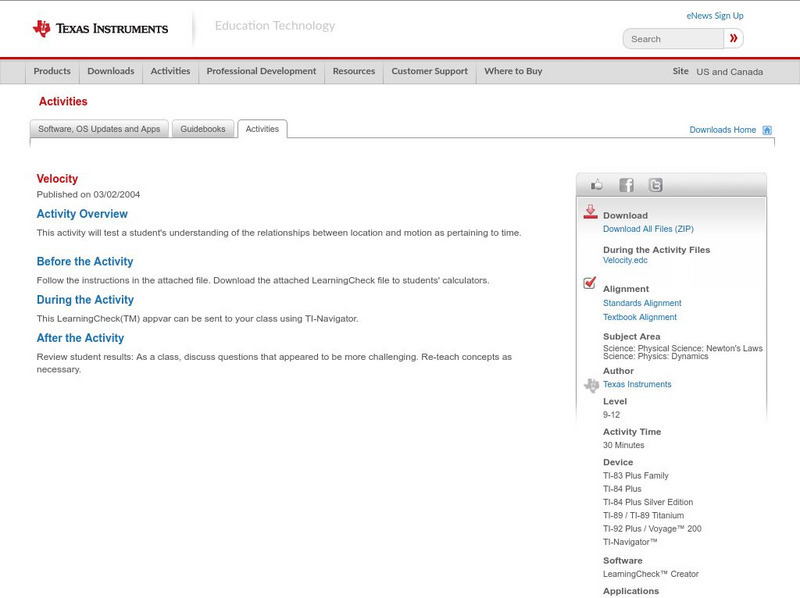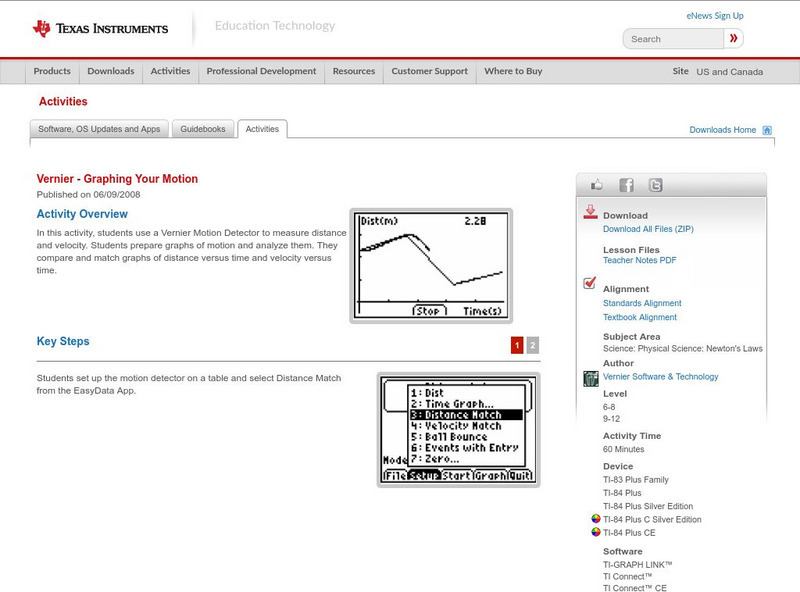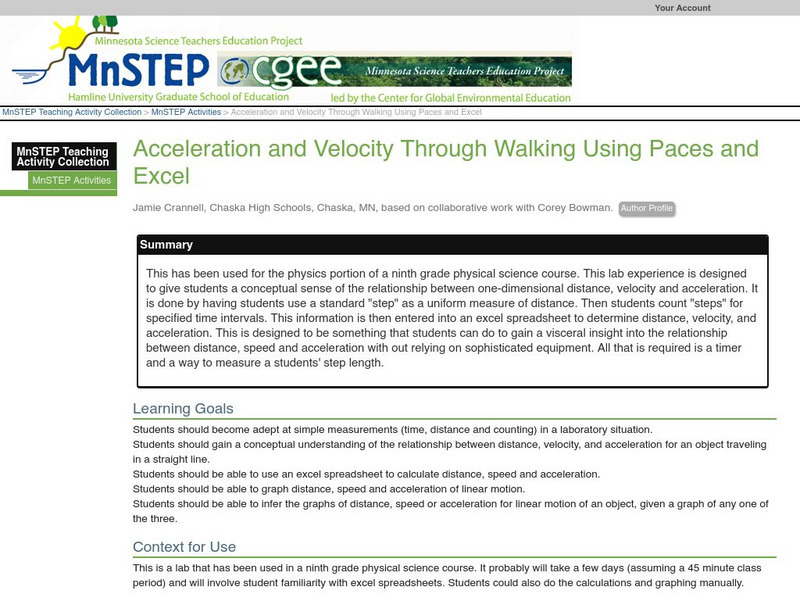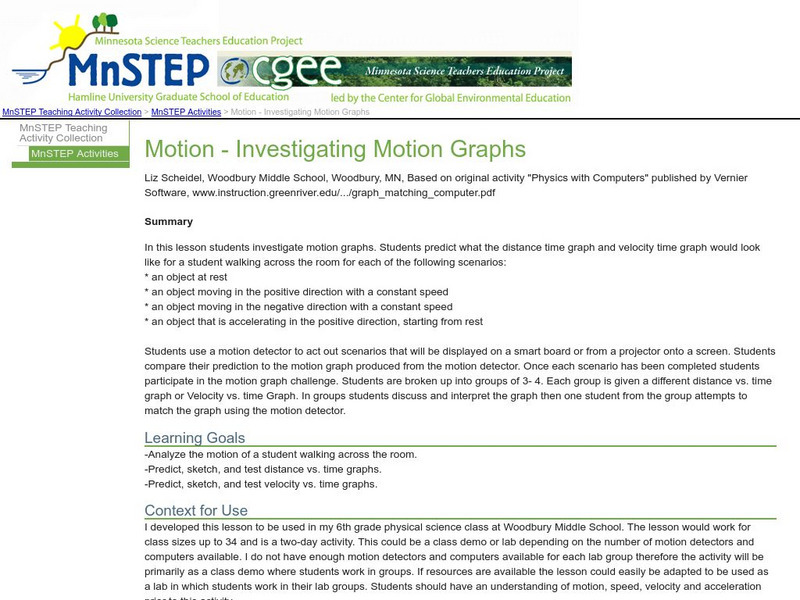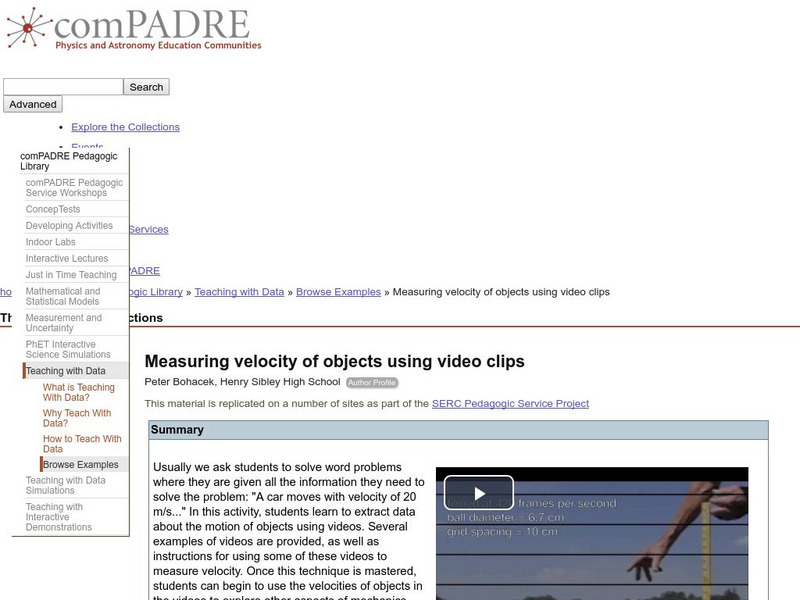Texas Education Agency
Texas Gateway: Types of Motion
Students will distinguish between and/or interpret the types of motion.
Texas Education Agency
Texas Gateway: Ap Physics: 2.3 Time, Velocity, and Speed
By the end of this section, you will be able to do the following: Explain the relationships between instantaneous velocity, average velocity, instantaneous speed, average speed, displacement, and time; Calculate velocity and speed given...
Texas Education Agency
Texas Gateway: Circular Motion & Gravitation: Rotation Angle & Angular Velocity
By the end of this section, you will be able to define arc length, rotation angle, radius of curvature, and angular velocity; and to calculate the angular velocity of a car wheel spin.
CK-12 Foundation
Ck 12 Exploration Series: Simulations: Physics: Model Rocket
[Free Registration/Login Required] Learn about the relationship between position and velocity for a model rocket during launch and in free-fall. Experiment with rocket mass, rocket thrust, and rocket burn time to understand the...
CK-12 Foundation
Ck 12: Instantaneous Velocity
[Free Registration/Login may be required to access all resource tools.] Students explore instantaneous velocity and how to calculate it. They also learn how interpret and create position vs time graphs.
Texas Instruments
Texas Instruments: Velocity
This activity will test a student's understanding of the relationships between location and motion as pertaining to time.
Texas Instruments
Texas Instruments: Graphing Your Motion
In this activity, students use a Motion Detector to measure distance and velocity. Students prepare graphs of motion and analyze them. They compare and match graphs of distance versus time and velocity versus time.
Texas Instruments
Texas Instruments: What's Your Speed?
In this activity, students' will use a motion detector to determine what effect the speed at which a person moves has on the appearance of the distance versus time plot.
Texas Instruments
Texas Instruments: Graphing Motion: Instantaneous and Average Speed
Students are introduced to the calculator as a graphing tool and distinguish between average speed and instantaneous speed.
Texas Instruments
Texas Instruments: How Incline Affects Speed
Students determine how incline affects speed. They will communicate their results graphically.
Science Education Resource Center at Carleton College
Serc: Using Velocity and Acceleration Vectors to Interpret the Motion of a Car
Students understand that vectors have both magnitude and direction components as they investigate velocity and acceleration vectors.
Science Education Resource Center at Carleton College
Serc: Motion: Speed of Automobiles
In this activity, students will determine the speed of a moving vehicle using a stopwatch and meter stick, then convert the measurement from meters/sec to miles/hr. After completing this activity, students should understand average...
Science Education Resource Center at Carleton College
Serc: Analyzing the Motion of a Marble Down a Ramp
This lab activity involves rolling a marble down a ramp where the students can investigate constant acceleration motion. The students then make a position vs. time graph and a velocity vs. time graph in order to investigate the change in...
Science Education Resource Center at Carleton College
Serc: Acceleration and Velocity Through Walking Using Paces and Excel
This has been used for the physics portion of a ninth grade physical science course. This lab experience is designed to give students a conceptual sense of the relationship between one-dimensional distance, velocity and acceleration.
Science Education Resource Center at Carleton College
Serc: Motion: Investigating Motion Graphs
In this lesson, students investigate motion graphs. Students predict what the distance-time graph and velocity time graph would look like for a student walking across the room for three different scenarios.
Science Education Resource Center at Carleton College
Serc: Investigating Speed and Velocity
In this investigation, middle schoolers will work in groups to design a model roller coaster, which will be used to clock the fastest speed for the rider (ball bearing/marble) The groups will build roller coaster models and modify and...
Science Education Resource Center at Carleton College
Serc: Graph Predictions for Position, Velocity and Acceleration
Students interactively create predictions of position, velocity, and acceleration graphs using java applets. The applets automatically classify student answers, so instructors can create graphs of student predictions.
Science Education Resource Center at Carleton College
Serc: Measuring Velocity of Objects Using Video Clips
In this activity, young scholars learn to analyze video clips and extract data about the velocity of moving objects, reinforcing the concept of average velocity. After mastering the technique of using videos to measure velocity, students...
Physics Classroom
The Physics Classroom: 1 D Kinematics: Table of Contents
Learners examine motion with words, equations, diagrams, and graphs. Some topics investigated are position, velocity, acceleration, and free fall. The tutorial consists of lessons and problems to check for understanding.
E-learning for Kids
E Learning for Kids: Science: Bay of Whales: Calculating Speed
Amelia is a researcher. She studies the speed of animals. Join her in Antarctica to help her figure these calculations.
TED Talks
Ted: Ted Ed: How Fast Are You Moving Right Now?
Tucker Hiatt unravels the concepts of absolute and relative speed. [6:10]
Open Curriculum
Open Curriculum: Velocity and Relative Motion
An illustrated article helps physics students learn about center of mass and velocity, and define the concept of inertia.
Other
Easyphysics: Chapter 2 Velocity
Learners investigate velocity. Some topics examined are average velocity, distance, and displacement. The resource includes example problems with solutions, interactive graphs, and a chapter quiz.
Other
Institute of Physics: Practical Physics: Speed Time Graphs to Find an Equation
An illustrated example of a speed-time graph plotted with speed on the vertical axis against time on the horizontal axis.







